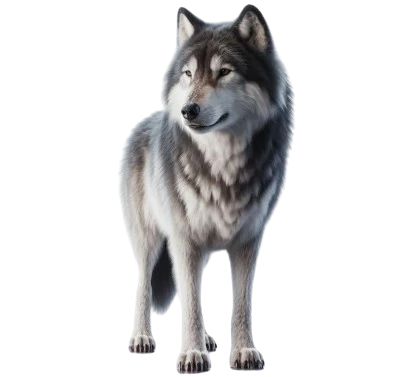
The Alaska Wolf (Canis lupus tundrarum) is a subspecies of the Gray Wolf, primarily found in the wild regions of Alaska. This powerful predator is perfectly adapted to the harsh conditions of the Arctic and mountainous environments.
The Alaska Wolf is a robust canid, measuring between 75 and 90 cm at the shoulder and weighing between 35 and 55 kg. Its thick and dense coat is primarily white or light gray, with variations depending on the seasons and climate conditions. Its large, pointed ears and bright yellow eyes reflect its alertness and intelligence.
The Alaska Wolf belongs to the same species as the Gray Wolf (Canis lupus), but it is a subspecies adapted to the extreme conditions of the Arctic.
This wolf is one of the largest in the canid family and has evolved to survive in cold, isolated regions.
The Alaska Wolf inhabits the vast boreal forests, mountains, and frozen plains of Alaska. It prefers remote areas, far from human activity. These wolves require large territories to hunt and maintain their social structure. Alaska, with its wild and isolated landscapes, is an ideal environment for them.
Like other gray wolves, the Alaska Wolf lives in organized packs, often led by an alpha pair. These packs typically consist of 6 to 10 members, who collaborate to hunt large prey such as caribou and moose. Wolves use a variety of vocalizations, gestures, and scent signals to communicate with one another.
An opportunistic carnivore, the Alaska Wolf primarily feeds on large mammals, such as caribou, moose, and occasionally elk. It hunts in packs, allowing it to take down prey larger and faster than itself. During periods of scarcity, it may also feed on smaller animals or carrion.
Although the Alaska Wolf is not yet considered an immediate endangered species, it faces threats, mainly due to human activities such as hunting and habitat loss. Sustainable ecosystem management and the preservation of its natural habitats are essential for maintaining stable populations. Conservation efforts are needed to prevent this subspecies from becoming vulnerable in the future.
The Alaskan Wolf, also known as Canis lupus occidentalis, is a subspecies of the gray wolf (Canis lupus). It shares genetic similarities with several other canids, notably the Coyote (Canis latrans) and the Golden Jackal (Canis aureus). These species share common characteristics such as their complex social structure and pack hunting behaviors.
Observing the Alaska Wolf in its natural environment is a rare privilege, but it is important to follow rules that ensure both their safety and yours. Here are some tips for responsible observation:
By following these tips, you help preserve the Alaska Wolves and their habitat while enjoying a rewarding and respectful experience.